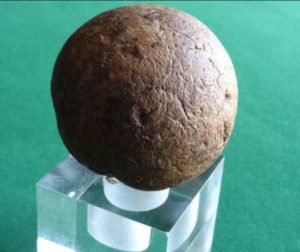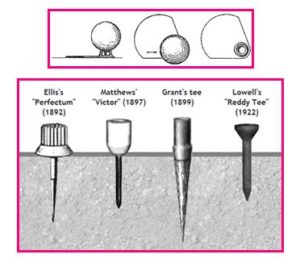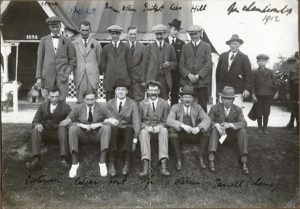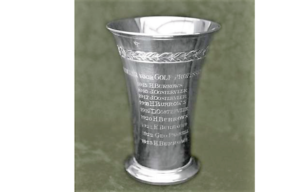Golf facts
Knowledge of the PRESENT, by drawing on the PAST. What do you know about ……
Section in which a contemporary golf object is explained from the golf history. Interesting to know yourself, even more fun to tell others.
What do you know about…
THE GOLF BALL
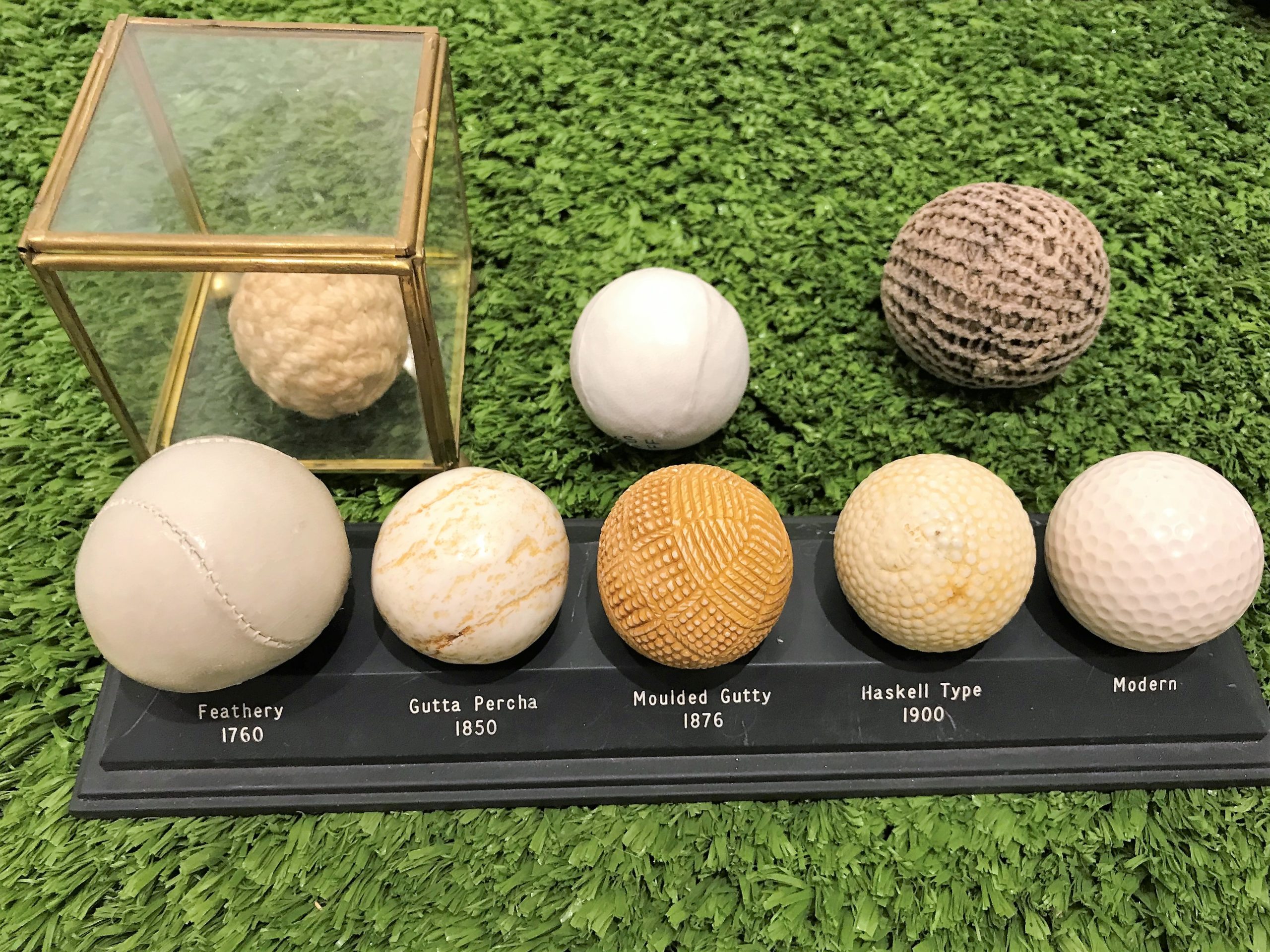
Knowledge of the PRESENT
Golf ball – A golf ball is a ball with a diameter of 42.67 millimeters with which the game of golf is practiced.

The current generation of balls often contains a rubber core surrounded by one or more layers of synthetic material. The outside of the ball (shell or cover) is made of different materials according to the needs of the player.
A harder shell ensures less spin so more direction, distance, durability, less “feeling” and a lower price. A softer skin ensures more spin, steerability, less distance, faster wear, more feel and a higher price.
Golf balls are available in many colors, but white is still the most common color because it is best visible at a great distance. Any other color absorbs more light than white.
The surface of the ball is provided with round, shallow dents (the so-called dimples). The number of dimples in the ball and its shape and distribution affect air resistance, which changes the ballistics of the golf ball. The general rule says that balls with many small dimples fly higher than balls with few large dimples. The number of dimples can vary from 300 to 812 pieces.
By drawing on the PAST
The ball is round
We probably all know stories about shepherds who hit stones with their inverted staff. But we leave the Stone Age for what it was and focus on real balls, such as those used in stick-and-ball games.
Wooden ball
As far as is known, the very first balls used in the colf game were made of wood. At least in the Netherlands. And as long as the contrary has not been proven, we also follow this general assumption. Whether that was also the case in Scotland outside the Netherlands, no convincing evidence has been found for this. The wooden balls were often made of the very hard boxwood or beech wood. Trees carved from the good wood, which were common in the Netherlands. They were slippery and flew no further than about 75 meters.
The “stoet”
Traditionally, a stoet was a ball wrapped of linen (textile) with which it was rolled (compare football). This stoet, hard but resilient, was also used for the “sollen metten colve” (compare hockey). How the stoet fits into the colf game as we mean it is not very clear. Colf written with a c, to distinguish it from contemporary golf, which is basically the same game.
Hairy ball
But already in the 15th century golf balls were developed from leather. First filled with cow hair or straw, the hairy. The ballers from Goirle became famous with it and exported masses of these balls to Scotland until the early 17th century.
Feathery ball
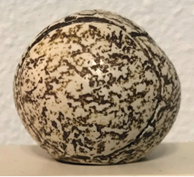
Later, the leather balls were filled with boiled compressed goose feathers or chicken feathers and painted. The penneball in the Netherlands became the famous featherie ball. Three pieces of cowhide were sewn together and then filled with the wet, long-boiled feathers. In one ball went a top hat full of feathers. When the ball was filled, the last stitching was closed with a fourth piece of leather and wet in a round shape hammered or pressed and then dried. By drying, the feathers expand while the leather shrank. This resulted in a rock-hard ball.
These feathery balls were very expensive, because the process was time-consuming. A ball maker could make at most three to four balls a day. In addition, these balls did not last long and were virtually impossible to repair. Yet this ball was the standard for more than three centuries. You could hit 180 meters with it.
Because these balls were so expensive, more expensive than a golf stick, even more expensive than a caddy, people did not want to lose them. Better than losing a ball, you could hire two caddies, one to carry the sticks and one, which you sent forward to see where your ball ended up, the so-called fore caddy.
Before they started hitting, they first warned by shouting loudly at him: “Fore! Caddy.” That meant for him that you were going to hit and that he had to pay attention to where the ball came down.
Gutta Percha-ball
In the search for cheaper balls, Robert Adam Patterson invented the “gutty” in 1848, a ball of gutta percha, the sap of the rubber tree of the same name from Malaysia in particular. At first it seemed to be a big failure, the balls fell apart after a few strokes, but eventually his brother developed a useful guttie ball. This guttie was still slippery at first.
Bramble
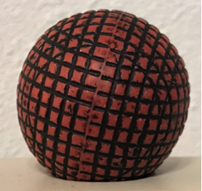
But it was soon discovered that the dents caused by the hitting positively influenced the ball flight. They began to apply these deliberately to new balls with a knife, hammer or chisel. These balls were called “Brambles”: blackberries because of their similarity to this fruit. But as mentioned, these balls sometimes fell apart when hitting. That is why a rule had been made that you could place a new ball where most of the smashed ball was.
Haskell-ball
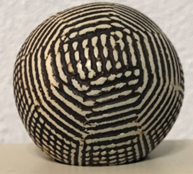
Around 1900 there was a new development by the American Coburn Haskell, who designed a ball from two parts: the first two-piece ball, which would substantially change the game of golf. The Haskell ball consisted of a rubber core wrapped with rubber wire.
Two-piece ball
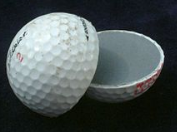
In the 60s of the 20th century new materials and better synthetic resins were found and today’s balls have two, three or even four layers and for every type of player there is a suitable ball.
See also the collection Golf balls:
What do you know about…
THE CRY: FORE

Knowledge of the PRESENT
Fore – mandatory exclamation as a warning if the ball is played incorrectly and goes in the direction of another player (or spectator).
Also used to draw attention, e.g. for a speaker or at an award ceremony.
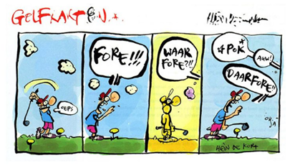
By drawing on the PAST
“Fore ! Caddy !”
Because around the year 1,400 feathery balls were so expensive, more expensive than a golf stick, even more expensive than a caddy, they did not want to lose them either. Better than losing a ball, you could hire two caddies, one to carry the sticks (bags came later) and one, which you sent forward to see where your ball ended up, the so-called fore caddy. Before they started hitting, they first warned by shouting loudly at him: “Fore! Caddy.” That meant he had to pay attention to where the ball came.
Flying Object
Yet that is probably not where the warning cry “Fore!” known in golf comes from. And it doesn’t mean Flying Object Returning to Earth either.
“(be)ware before”
The most widely held explanation is the John Knox story from the 16th century. Then at the east gate of the town of Leith in Scotland there were two cannons that served as a defense against ‘Englishmen and other scum’. The east gate overlooked the left, a piece of land where golfers played, who had a lot of influence in both politics and golf.
When the gunners saw suspicious figures looming in the distance, they shouted at the defenders at the gate and at the golfers on the left “(be)ware before” (watch out, there from the front) after which the defenders threw themselves flat on the ground. Then the cannon shots rang out. Among the golfers, the abbreviated fore has lingered as a warning and has been spread by them further across Scotland. From there on to the rest of the world.
What do you know about…
A LINKS COURSE
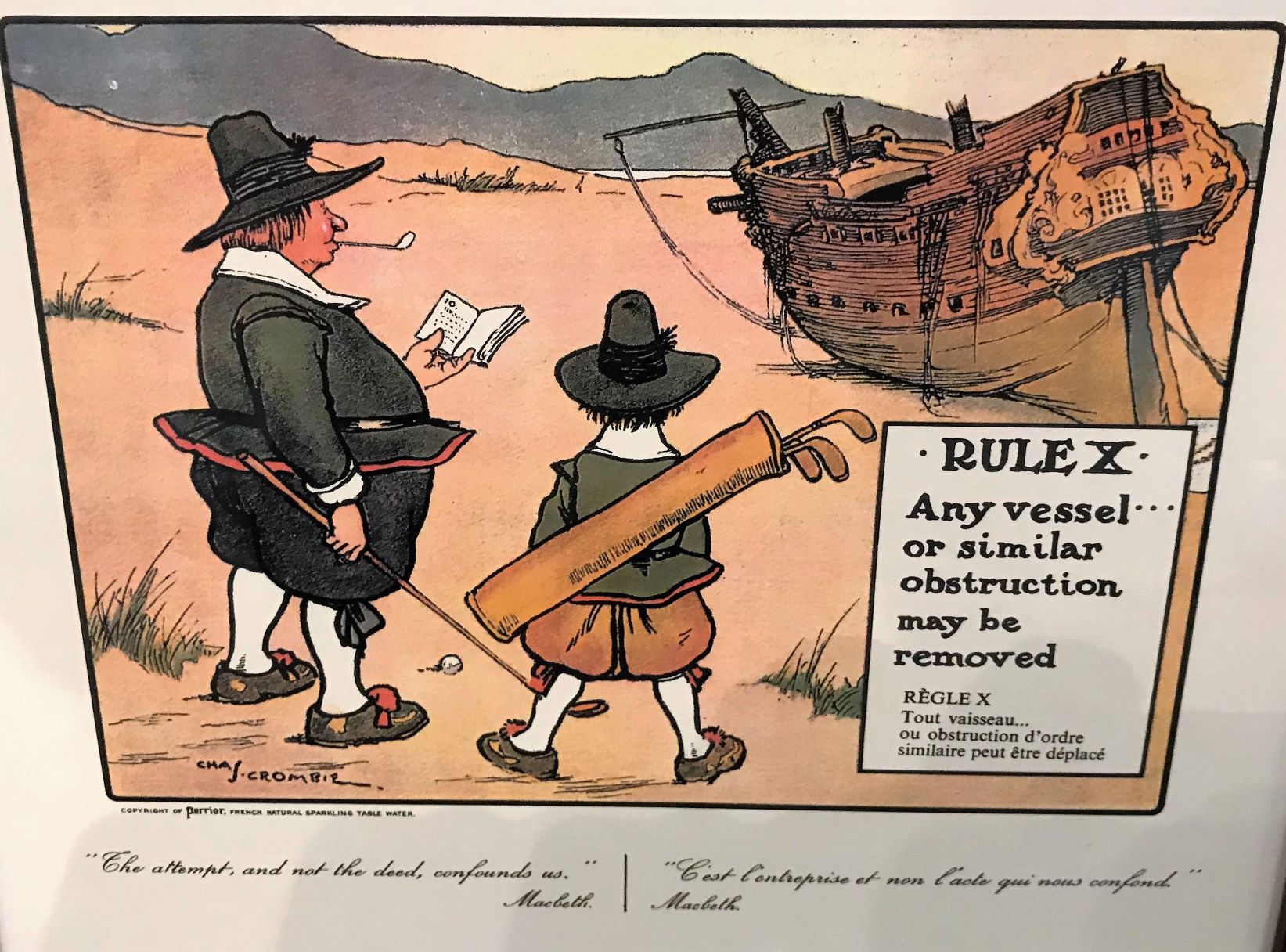
Knowledge of the PRESENT
Links – The name for a golf course that is located in the barren and infurtile, sometimes slightly salty sand and dune area, right behind the sea. The oldest Scottish golf courses were links courses.
By drawing on the PAST
The origin of the name “links” is often misinterpreted as having to do with the word “link” that means link. Probably also because the early courses in Scotland such as St Andrews did indeed tie the holes together. People still speak of “Oudward nine” and “Inward nine”.
But “Links” in golf comes from the Old English “hlinc” which means a land ridge or a bank. From the ice age, pebble-like soil structures remained on the coast where, after erosion, growth formed. Especially a tough salty type of grass “fescue” that turned out to be excellent grass, but only for sheep.
Almost all of this land was community land with no specific owner. Land that had been grazed only slowly grew back. And on that land, the Left’s wave began that would always have its own character. The soil allowed water to pass through easily, while retaining enough moisture for the growth of the fescue grass. So it’s ideal. That is, if it was short. The wide leaves make fescue grass a nightmare to strike out.
But as golf became more popular, certain plots of land became eligible to be used almost exclusively for golf. Especially along the English coast. The grass had to be kept a bit short by hand, because the sheep no longer did that. And that was quite a job.
It should have been a relief when the mower was invented in 1830. Still pulled by horses of course. But strangely enough, people on the left still stuck to mowing by hand: with the scythe. It wasn’t until 1980 that mowing with a machine was used at Elie golf club in Scotland.
With us in the Netherlands, the 9-hole course of the Domburgsche Golf Club comes closest to the primal shape of the links.
What do you know about…
PAR
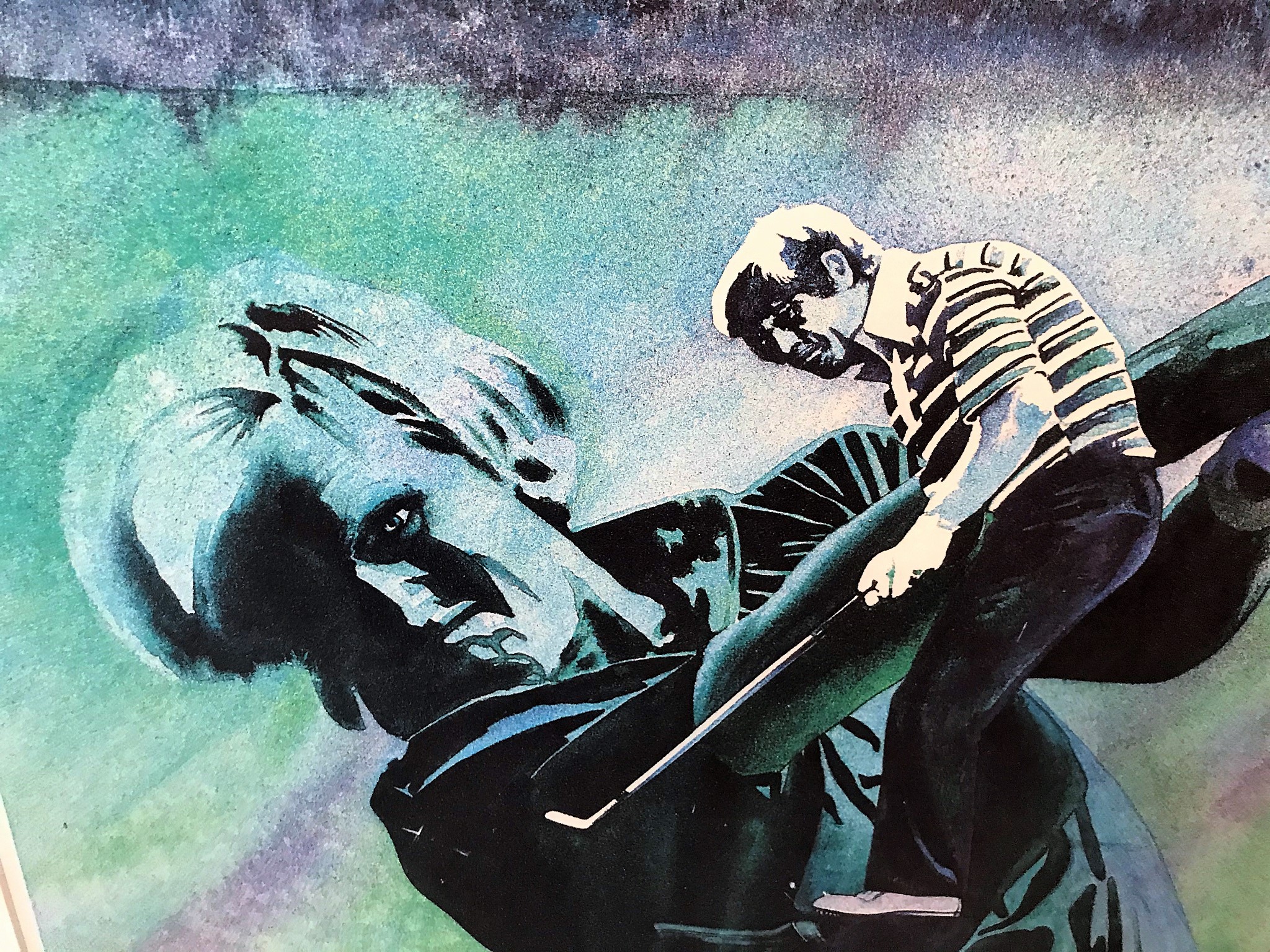
Knowledge of the PRESENT
PAR is the score that can be expected from an excellent or scratch player on each given hole. A score in par actually means nothing more or less than playing the hole flawlessly under normal conditions.
In addition, one stroke to the green is calculated on a par-3, two strokes on a par-5, three on a par-5 and, once on that green, no more than two putts per hole.
For example, PAR could refer to Professional Average Result, which is thought. But nothing could be further from the truth.
By drawing on the PAST
The word par is derived from the Latin word for equal.
Groundscore
In the time of Pieter van Afferden (around 1550), however, there were no beautifully landscaped courses with a standard for good golfers. One just had to keep playing until it was holed out.
Until Hugh Rotherham, secretary of Coventry Golf Club, thought it a good idea in 1890 to determine the number of strokes that a good golfer should get for each hole to be played. He called that the ‘ground score’. Dr. Browne, secretary of the Great Yarmouth Club adopted this idea and with the agreement of the club golfers, a standard was established for use in the match play competition.
Bogey-score
During a competition day, Major Charles Wellman lashed out at Dr. Browne: “This player of yours is a regular Bogey man”. Probably referring to a very popular Edwardian music hall song “Hush! Hush! Hush! Here Comes the Bogey Man”.
A ‘bogle’ was already a Scottish evil spirit before that time and a Bogey man, an ogre, was a widely used term for an evil spirit or devil. Golfers found that they were playing against a Mister Bogey when they set their own score against the standard of the course. And so the way was open for bogey competitions, the later handicap or stableford competitions. And so in Yarmouth and elsewhere the ground score became known as the bogey score.
PAR-score
As golf developed and players continued to hit, the scores gradually improved and good golfers and professionals regularly got better scores than the bogey score.
The Americans then said ‘par’ to the player which meant ‘good’. They matched the practice better with their distances than the British bogey standard, which was no longer sufficient for professionals. The Americans began to name a bogey as one over par, much to the displeasure of the British.
In 1914, however, voices emerged to change the standard in line with the Americans and in 1925 the time had come.
What do you know about…
THE TEE-BOX
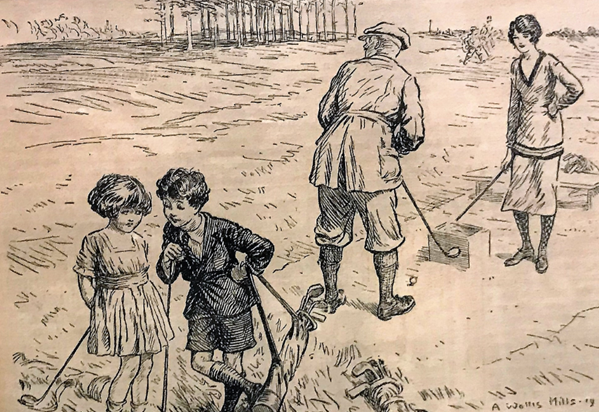
Knowledge of the PRESENT
In golf, the tee (also called tee-box) is the place from which the first stroke (drive or tee) for the hole is played.
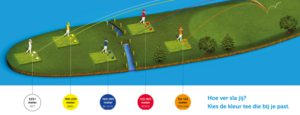
More specifically: the tee box is the visually determined and marked rectangular area within which it is allowed to strike by means of two left and right placed marks (markers) and the by no more than two stick lengths to the rear. That is to say: the ball must be raised within those limits (under penalty of 2 penalty strokes), because the player himself can and may also take his position outside that area. The tee markers may not be moved on the tee-box turn (also under penalty of two penalty strokes).
A tee is also a wooden or plastic pin where the ball is placed and then knocked off. This is called opteeën.
The use of a tee is in principle only allowed on the tee box, unless opteen by the track is allowed or even mandatory to protect the track.
In a bunker or outside the fairway (in rough or obstacle) the use of a tee is not allowed. After hitting, the used tee must be removed by the player, even if it has been smashed.
A standard tee is 2 1/8 inches or 5.4 cm long, but longer and shorter tees are allowed according to the player’s wishes.
By drawing on the PAST
De geschiedenis van de tee dateert al vanaf de 15e eeuw.
Zelfs in de begindagen van golf vonden spelers het gemakkelijker om de bal van een kleine hoogte af te slaan dan direct van de grond. Men maakte daarvoor aan het begin van een hole met de handen en wat nat zand een hoopje, waarop de bal kon worden geplaatst. Met een natte doek werden de handen weer schoon geveegd.
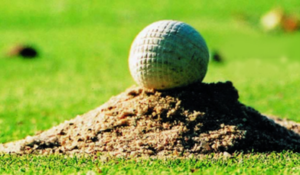
De naam tee is afkomstig van het Nederlandse tuitje, zoals het zandhoopje in Nederland werd genoemd. Deze praktijk heeft ruim drie eeuwen stand gehouden alvorens er in de 18e eeuw verandering in kwam.
Het zand voor de tee van de volgende hole was afkomstig uit het gegraven kuiltje van de vorige hole, waar men de bal in moest slaan.
Zo lezen we in een van de 13 originele golfregels van 1744: ‘Your Tee must be upon the Ground’. De spelers mochten dat doen binnen een stoklengte van de oorspronke lijke hole en met gebruikmaking van de daar aanwezige grond.
Het was de dokter John Rattray die, om een eerlijk spel te krijgen, deze regels had opgesteld ter gelegenheid van een golftoernooi op de links van Leith, waaraan meerdere deelnemers meededen.
Naarmate het spel zich verder ontwikkelde ontstond de behoefte om het uitholen en het afslaan op gescheiden plekken te laten plaats hebben en zo ontstonden aparte teeing grounds en putting areas. De eerste golfbaan die dit had was St Andrews na een vernieuwd ontwerp van Old Tom Morris in 1875.
In RULES FOR THE GAME OF GOLF as it is played by the Royal & Ancient Golf Club of St Andrews over the Links van september 1875 lezen we:
The ball must be teed not nearer the hole than eight nor farther than twelve club lengths, except where special ground has been marked by the Conservator of the Links, which shall be considered the ‘teeing ground,’ and the balls shall be teed within, and not in advance of, such marks.
Omdat het zand nu niet meer van de plek zelf kwam werd het bewaard in een metalen bak, waar de golf term tee-box vandaan komt.
Voor veel golfers werd deze procedure te omslachtig en men ging al vroeg op zoek naar een draagbare vervanger van het hoopje zand of aarde.
Er volgden een aantal ontwerpen en evenzovele patenten, de eerste uit 1889.
Van T-tees van Bloxsom en Douglas, die op de grond werden gelegd (1889) tot T-tees, die in de grond konden worden gestopt, zoals de “Perfectum” van Percy Ellis uit Surrey (1892) en de “Victor” tee van de Schot Premier Matthews (1897), en ook daarna waren er nog een aantal uitvindingen, o.a. van Dr. George Grant (1899).
Maar geen ervan kon echter de oude traditie van het stapeltje zand vervangen.
Tot in 1920 Dr. William Lowel, een tandarts uit Maplewood, New Jersey, op het idee kwam van een berken houten tee, die later de standaard werd, de “Reddy Tee”.
En daarmee verdween de oorspronkelijke Tee-box voorgoed.
What do you know about…
THE SCRATCH PLAYER

Knowledge of the PRESENT
The Scratch player is the golfer who does not have a handicap, so handicap 0, and plays “from scratch”.
By drawing on the PAST
Starting from scratch in everyday English means something like, starting from nothing. An architect who has to design a house: has to start from scratch, the first line has yet to be set.
However, it is also said: Is he up to scratch? In other words: can he handle it? The latter is now believed to be the origin of “scratch” in golf: “Is he/she up to scratch for the course”.
But how do we get that term. Because in the match play days there was no standard score for a job at all and the term was therefore superfluous. As with many other expressions, there are multiple explanations, but we find the following most likely:
In the early 1800s, many boxing matches were held in England. They were called “Knuckle fights” because they fought with bare fists. There were no rules yet and there was fighting until one of them could no longer do so.
In order to determine whether someone was still reasonably capable of defending himself, the following standard was used. Before the fight started (just somewhere outside, there was no ring yet) a line was drawn on the ground: “the scratch”.
From there, the opponents walked to the place where the fight took place, about twenty meters away. When one of them was knocked down, he had to get up from the referee and walk to the scratch. If he could touch that line, he was still able to fight on. If he didn’t make it, “he wasn’t up to scratch”. Not up to the opponent.
In golf you are no match for all our opponents: THE COURSE!
What do you know about…
THE MULLIGHAN

Knowledge of the PRESENT
Mullighan – Only by appointment between the players of a game, only on the first hole and only if it is a friendly game, it can be agreed that if the first drive is missed, a second can be struck, where both strokes then count as one.
By drawing on the PAST
The term Mullighan is not entirely certain where he comes from, but a well-known anecdote has remained of it.
At the beginning of the last century, an increasing number of golf courses were built in America. Mostly by imported Scottish golfers. Especially in the South, of course, a lot of land was available after the civil war of 1860 had set aside much of the former country aristocracy.
During that period, many Irish immigrants came to the USA because of the famine that broke out in Ireland. But not only people’s movers. Also landowners who no longer pruned the English regime. One of them settled in one of the southern states and became a successful cotton planter. However, he had also brought the sport of golf with him and had his own golf course built on his land. In this case, the Irish landowner was a certain Colonel Thomas Mullighan.
A somewhat irascible and short-tethered personality who nevertheless liked guests.
When they played a game of golf together, it was taken for granted that the Colonel was the first to tee off. However, he had been a better soldier than golfer and his tee went into the deep rough many times. It was his habit to calmly put down a new ball and continue with it. Nothing provisional. And no one got it in their head to count the first blow.
This of course became common knowledge and so the habit arose to say with a wink when someone else also missed his first turn elsewhere: …. “A Mullighan maybe?”.
What do you know about…
STABLEFORD

Knowledge of the PRESENT
Stableford – Stableford is the scoring system that makes it possible for players of different levels to play fairly and equally against each other. Stableford scoring ensures that a bad score on certain holes weighs less heavily in the final result.
You can earn points per hole played. The better you score, the more points you earn. In a stableford match, the number of strokes you can do over a hole depends on your handicap. The higher your handicap, the more strokes you can do over a hole. The lower the handicap, the fewer strokes you get ‘gift’.
By drawing on the PAST
Anyone who thinks or may have ever thought that the inventor of the popular Stableford scoring system was a bad golfer is wrong.
The Englishman Frank B. Stableford was not only a surgeon, he was also a golfer with a handicap of plus 1 …!
He invented the scoring system that bears his name and that was tested for the first time in competition form at the Wallasey Links in Chestire, England, in May 1932, so not for himself but for all the lesser golf gods among us.
After all: if you used to – and still do now – forget it with a 10 on the map, under the Stableford points system that does not have to matter.
In fact, with one or more stripes on the map you can even win the match quietly. Stableford did not start from the number of strokes per round played (such as the Strokeplay match form), but from the point or points that you can earn by means of that number of strokes on each individual hole:

What do you know about…
DROPPING A BALL
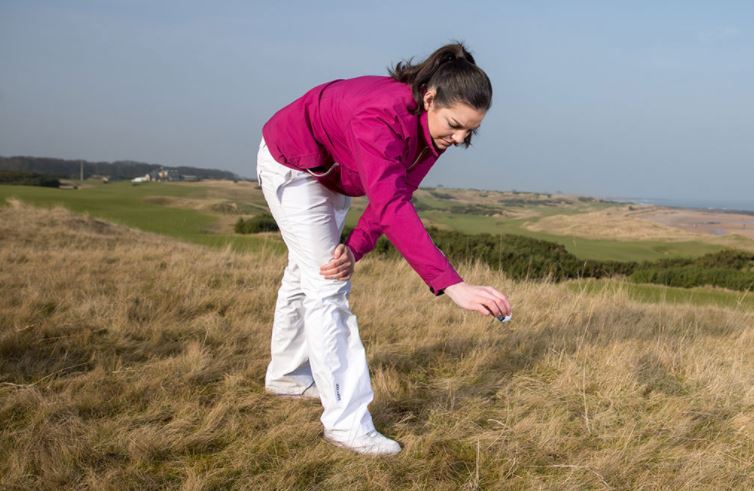
Knowledge of the PRESENT
Dropping – Releasing the ball from the hand so that it falls through the air, with the intention that the ball comes into play. When dropping, the player must release the ball at knee height in such a way that the ball:
- Falls straight down, without the player throwing, twisting or rolling it or using any other movement that could affect where the ball comes to a stop.
- Nowhere does the player’s body or equipment touch before hitting the ground.
By drawing on the PAST
A charming, but evolved phenomenon is the old fashioned dropping of a ball. Drops are still being done, but since 2019 this is done from knee height by the player himself who is not allowed to bring his knee closer to the ground than when he is standing upright.
But before that, dropping has been through a lot. In 1545 there was no dropping: one had to play the ball as it lay. If that was impossible, then this was not provided for, at least not in the rules as they came to us through the Tyrocinium of Pieter van Afferden. Even in 1744, leith was not concerned about the way in which to drop.
The game had to continue, that was the most important thing. In 1765, at St. Andrews, the ball was allowed to be taken out of the water and thrown at least 5 meters behind the hazard.
But in the course of history, dropping was further refined. And each time they tried to put an element of honest unpredictability in it.
For example, in 1773 the ball had to be dropped by the opponent. In 1776, the player had to do it himself again, but by throwing the ball backwards over his head. In 1807 the player had to drop the ball over his shoulder behind him and in 1839 the right shoulder was designated for this. The player had to face the hole.
At one point, the latter didn’t matter, as long as the ball hit the ground within the designated area. Often it was about centimeter work, because closer to the hole was not allowed at that time. But how do you ensure that the ball falls behind your back? Therefore, from 1984 onwards, the player himself had to drop:
standing upright, holding the ball at shoulder height and with outstretched arm and then dropping it. In this way it was possible to determine exactly where the ball should possibly be placed if necessary.
(Source: 100 years of golf in the Netherlands).
What do you know about…
THE STYMY
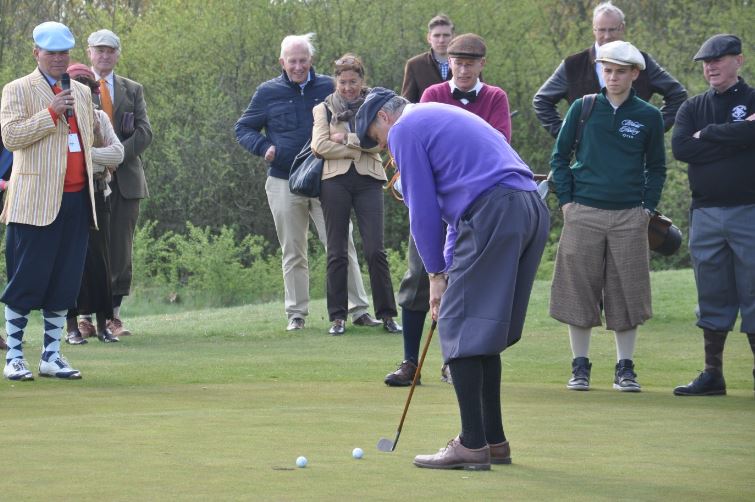
Knowledge of the PRESENT
Stymy – The stymy, a typical word that originates in golf, which means: preventing or hindering the progress of a golf ball that goes to the hole (according to a dictionary from 1857).
The stymy was a strategic ball in match play, but was abolished worldwide in 1951.
In the current wave, it is mandatory to mark a ball that is in the way and temporarily take it away. Even a marker that is on the green in the way should be moved a hole head length to the left or to the right if requested, and then put back in place.
By drawing on the PAST
De blokkade van een bal werd een stymie genoemd als twee ballen in een directe lijn van elkaar, maar met tenminste 6 inch ertussen, op de putting green lagen. Was er minder dan 6 inch ruimte tussen de ballen, dan werd de blokkerende bal wel opgetild omdat de ruimte dan te klein werd geacht om om de blokkerende bal heen te kunnen spelen.
Het woord ‘stymie’ komt oorspronkelijk van het Nederlandse ‘stuit mij’, ofwel het stopt mij, en is een zoveelste voorbeeld van de invloed van het vroege golf uit Nederland op het latere mondiale golf.
Al in het midden 18e, begin 19e eeuw ontwikkelden zich regels rond de stymies. De stymie was van oudsher een strategische bal in matchplay waarbij golfers hun bal zo probeerden te spelen dat deze in de lijn van de putt van hun tegenstander kwam te liggen.
Bij een stymie kon de blokkerende bal niet worden verplaatst. De speler die verder van de hole lag, en dus aan de beurt was, moest er een weg omheen of overheen zien te vinden. Onmogelijk? Kijk dan maar even naar https://youtu.be/0wJbD_w0TaI
Kon de stymie dus daadwerkelijk met opzet “geplaatst” worden, onopzettelijke stymies kwamen het meeste voor en de tegenstanders van de stymie kregen langzaam maar zeker de overhand. Nadat de R&A de stymie in 1833 voor een proefperiode van een jaar verbannen had, besloten R&A en USGA gezamenlijk de stymieregel in 1951 voor eens en altijd te schrappen.
What do you know about…
THE BIRDIE
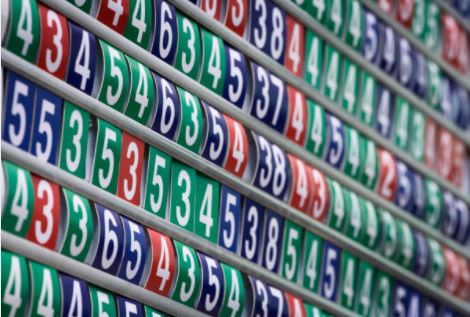
Knowledge of the PRESENT
Birdie – A birdie is the general term for a score of one under par on a hole. It is often indicated on the scorecard by circling the score.
On leadingboard and (digital) score boards, strokes below and above par are often indicated with a color.
By drawing on the PAST
In the past, there was no standard for the job. The places where golf was played did not really lend themselves to that either. But as there were real golf courses, one could better estimate who played well and especially consistently good.
For example, in 1890 Mr. Hugh Rotherham, secretary of Coventry Golf Club, came up with the idea of standardizing the number of strokes a good golfer needed to play a particular hole and he called that the ‘ground score’.
That idea was adopted by Dr. Browne, secretary of the Great Yarmouth Club and, with the consent of the members, introduced for use in the match play competition.
During such a league match, Major Charles Wellman sighed to Dr. Browne about his opponent: “This player of yours is a regular Bogey man”.
From that moment on, bogey was the ground score. Later, in the mid-20th century, par became the standard and bogey became the term for one over par.
In America, where ‘par’ was the standard for good golfers much earlier, the following story goes:
In 1898 or 1899 (Atlantic City County Club even mentions 1903) brothers Ab and William Smith and their friend George Crump played the par-4 second hole at Atlantic City CC. When Ab struck his second shot, his ball ended up just a few inches from the hole. Delighted, he exclaimed: “That was a bird of a shot!”. And he felt he should get double money if he won the hole one under par.
The other players agreed and Ab did indeed win the hole with one under par. Since then, the three have called a score of one under par a “birdie.”
A birdie is not a bird, but the term comes from the early 20th century American snake where ‘bird’ has the meaning of ‘something excellent’.
The term ‘birdie’ did not come over the Atlantic until 1913 and Bernard Darwin wrote about his visit to the USA in the September issue of Country Life:
“It takes a day or two for the English onlooker to understand that … a ‘birdie’ is a hole done in a stroke under par.”
Double birdy is an eagle.
How do we get there, except through the literal translation, to think through birds?
We, in this case the Americans, have come up with the idea of labeling ‘very, very good’, being two strokes under par, as a more prestigious bird and that is their national bird, the ‘eagle‘.
And even better, namely three strokes under par, we think it is an ‘albatross‘. A more rare and also larger bird, matching a double eagle, which is also not so common. The albatross is more of a British term, because the Americans stick to ‘double eagle‘ for country-loving reasons.
An eagle on a par-3 and an albatross on a par-4 is called an ‘ace‘ or hole in one and costs the lucky one a round for the entire clubhouse. But you can insure yourself for this nightmare.
A hole in one on a par-5, on the other hand, is called ‘big talk’ and was even considered impossible for a long time. Only a few cases are known and the players themselves are still wondering if a joke has been played with them.
Yet golfers also have a name for this and that is ‘condor‘.
So they became birds and the birds are getting bigger and bigger.
What do you know about…
THE DUTCH OPEN

Knowledge of the PRESENT
The Dutch Open – In good English: the open Dutch championships for golfprofes-sionals. But amateurs are allowed to participate.
The oldest international tournament in the Netherlands was played this year (2021) at Bernardus Golf in Cromvoirt. In the photo, two board members of the Dutch Golf Museum hand over the cup to tournament director Daan Slooter.
In the end, the Swede Kristoffer Broberg received the cup. For the photo moment then, because after that the change cup quickly went to the Dutch Golf Museum.
By drawing on the PAST
This year (2021) was the 101st edition in the 109th anniversary of the Dutch Open, which started in 1912. The field of participants was then rather modest, see the photo below:
It was Robbie van Erven Dorens (Mister Golf) who managed to push the Dutch Open to great heights over the years. As an organizer on behalf of the NGF, he managed to connect major sponsors (including KLM) to the tournament, as a result of which more and more well-known golf names came to the Netherlands as participants.
100th anniversary
In years when the world was on fire, it was not always possible to play. The 100th anniversary of the Dutch Open in 2012 has been commemorated with a gift from KLM and TIG Sports to the organization.
The 100th time that the Dutch Open was played, that was in 2019, was also graced with a special gift to the organization: a composition of the Night Watch by Rembrandt van Rijn with eleven former winners of the Dutch Open. Do you recognize Maarten Lafeber and Joost Luiten?
Dutch Open-cups
The current cup is the third Dutch Open cup. The first cup of 1912 was won three times by Henry Burrows, who was allowed to hold the cup afterwards.
This ‘Burrows’ cup was succeeded by the ‘Boomer’ cup that Aubrey Boomer was allowed to hold after also winning three times (even in a row: 1924 -1926).
With the third exchange cup, the current one, it has been decided that it will never become the property of a winner. And a good thing too, otherwise we would have been two cups further. The Belgian Flory van Donck takes the crown with no less than five wins.
There are two Dutchmen who have won the Dutch Open several times. In 1919 and 1930 that honor was reserved for Dirk Oosterveer. More recently, Joost Luijten won the Dutch Open cup in 2013 and 2016.
Incidentally, a Dutch championship already took place in 1896. That was still between players from the then existing clubs, the Doornse GC, the Haagsche GC, the Hilversumsche GC and the Kennemer. The winner of this championship, which is seen as the forerunner of the Dutch Open, was Walrave Boissevain of the Kennemer.

